Special cutting techniques defined in my article My analysis of puzzle cutting styles and examples cut into Full of the Dickens are:
 1 Color line cutting
1 Color line cutting
Most of the sections have some color line cutting. A good example is the coach and horse in John Stokes' section, Nicholas Nicklebys Departure for Dotheboys Hall
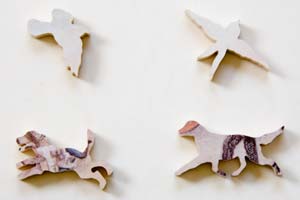 2a Figure pieces-normal
2a Figure pieces-normal
Again, most sections have figure pieces, but Pagey Elliott is the queen of animal figure pieces so I am displaying some of hers.
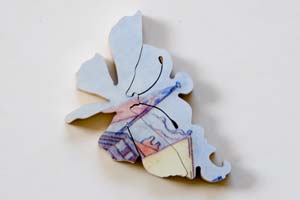 2b Figure pieces-enhanced
2b Figure pieces-enhanced
Usually this technique employs cut lines into the figure piece itself to enhance its appearance. Bruce Gehman in The Election at Eatanswill used cut lines in the adjacent pieces to simulate the antennae for his butterfly figure piece.
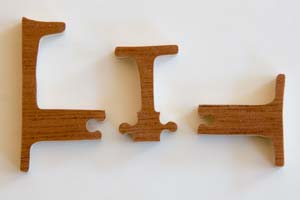 2c Figure pieces-complex
2c Figure pieces-complex
Not often used by today's cutters, Melinda employed it by cutting the "F" in Full of the Dickens into three pieces.
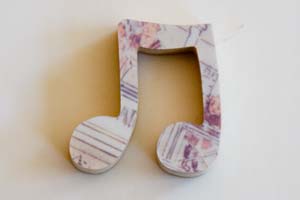 2d Figure pieces-personalized
2d Figure pieces-personalized
Aware of Hildegard's and my love for classical music, Mark Cappitella cut a pair of musical notes into David Copperfield Arrives in London. Of course, the entire concept behind the puzzle is personal to me, especially the central pop-up figure of Mr. Pickwick.
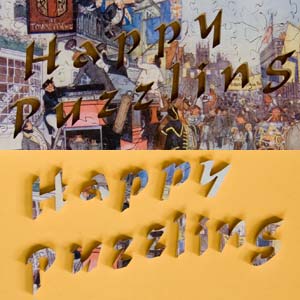 2e Figure pieces-message
2e Figure pieces-message
Bruce Gehman cut "Happy Puzzling" into The Election at Eatanswill, not only a message but also a personal message since I frequently sign correspondence this way.
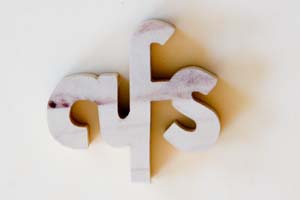 2f Figure pieces-signature
2f Figure pieces-signature
Most of the makers cut their signature pieces into their sections signing them on the back. Amy Finley Scott employed a particularly attractive monogram for her signature piece in David Copperfield Bids Farewell to the Micawber Family. The figure pieces of all the makers are identified later in this article.
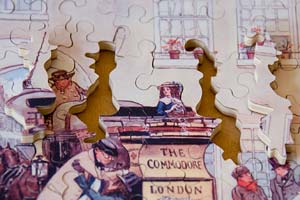 2g Figure pieces-appropriate
2g Figure pieces-appropriate
Elizabeth of Stave Puzzles did a wonderful job of positioning 2 figures of a man and a woman perched on top of the coach in Mr. Pickwick, his Friends and Mr. Jingle Start for Rochester.
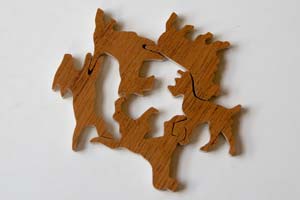
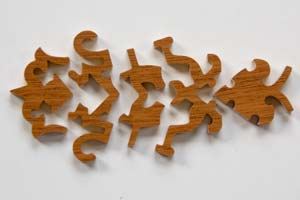 2h Figure pieces-interactive
2h Figure pieces-interactive
Graham Curtis' 5 frolicking dogs are interacting with each other in The Pickwickians Leave the Golden Cross for Rochester, and 5 geometric figures in the same puzzle fit together. While traditionally, interactive figure pieces touch each other (as they do here), they can still inter-act a short distance from each other.
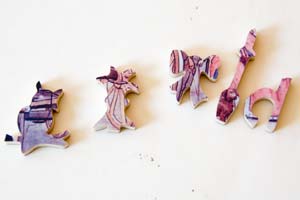 2i. Figure pieces-rebus
2i. Figure pieces-rebus
The rebus in the Stave Puzzle Mr. Pickwick, his Friends and Mr. Jingle Start for Rochester is not an easy one to solve but we think it combines owl, oil, bow, oar and d to spell a Cockney sounding version of All Aboard. Any other ideas?
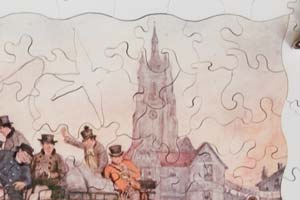 3a Irregular edges-non-straight
3a Irregular edges-non-straight
The Pickwickians Arrive at Eatanswill cut by Pagey Elliott has a lovely scalloped irregular edge on all four sides.
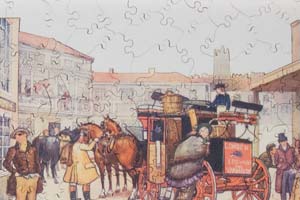 3b Irregular edges-outline
3b Irregular edges-outline
The top edge in David Copperfield Arrives in London cut by Mark Cappitella outlines the buildings in the background.
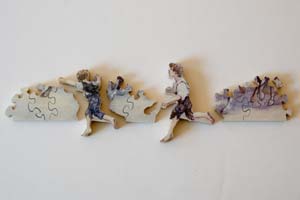 3c Irregular edges-protrusion
3c Irregular edges-protrusion
Graham Curtis has neatly cut around the protruding legs of the running boys in The Pickwickians Leave the Golden Cross for Rochester so as not to leave clues for anyone lining up and assembling the bottom edge pieces.
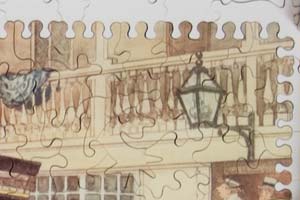 3d Irregular edges-knobs
3d Irregular edges-knobs
To make the irregular edges-knobs in David Copperfield on his way to School to fit into the surrounding white background, David Beffa-Negrini must have double cut the edges with the white background forming the bottom layer. No lining up of flat edge pieces in this puzzle!
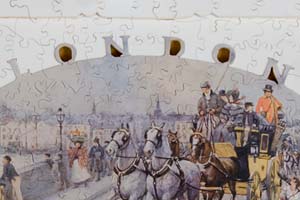 3e Irregular edges-figures
3e Irregular edges-figures
"London" forms the irregular edge-figures in David Copperfield's First Sight of London cut by Anne Williams.
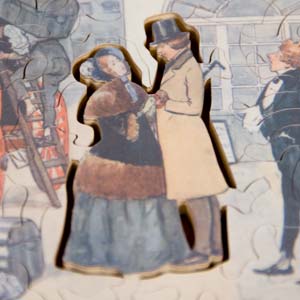 4a Dropouts-enhancement
4a Dropouts-enhancement
Conrad Armstrong (our son) has used dropouts to enhance Pip and Estella in Pip and Estella at the Inn Yard.
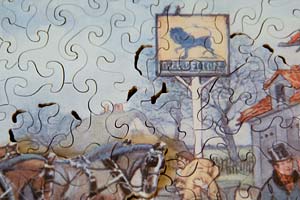 4b Dropouts-deception
4b Dropouts-deception
By dropping out small areas among the trees Melinda is deceiving the assembler in Mr. Pickwick and his Friends Arrive at the Blue Lion.
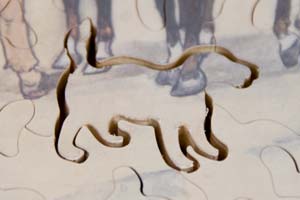 4c Dropouts-figures
4c Dropouts-figures
Conrad Armstrong has used dropouts to create the figure of a dog standing by the coach in The Meeting of Pip and Estella at the Inn Yard, appropriate for the scene.
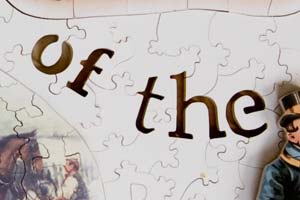 4d Dropouts-sculpting
4d Dropouts-sculpting
In the puzzle title Full of the Dickens has used dropouts-sculpting to create figures spelling "Dickens".
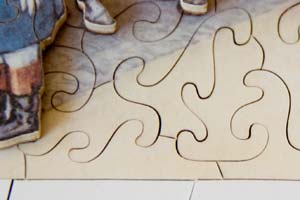 5a Disguised edges
5a Disguised edges
Melinda has employed disguised edges along the edges in Mr. Pickwick and his Friends Arrive at the Blue Lion.
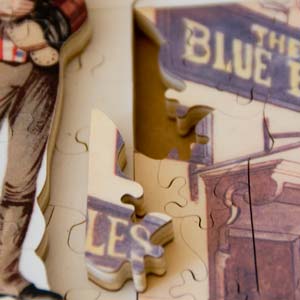
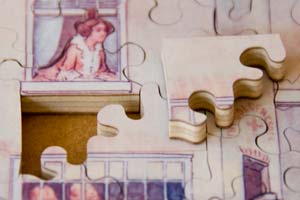 5b inside edges, corners
5b inside edges, corners
Mark Cappitella has cut inside edges inside David Copperfield Arrives in London. Stave Puzzles has inserted an inside corner in Mr. Pickwick, his Friends and Mr. Jingle Start for Rochester.
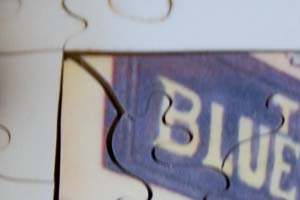 5c Split corners
5c Split corners
Mark Cappitella has neatly split several corners in David Copperfield Arrives in London.
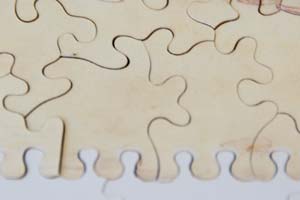 5d Split knobs
5d Split knobs
David Beffa-Negrini has split several knobs in David Copperfield on his Way to School.
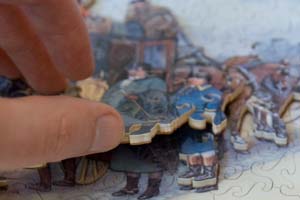 6a Multiple levels-same picture
6a Multiple levels-same picture
Melinda has cut two copies of Mr. Pickwick and his Friends Arrive at the Blue Lion so that the raised image of the coach and boys is the same on both levels. She has anchored the top section to the bottom by gluing key pieces together in four separate areas.
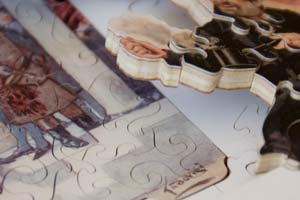 6b Multiple levels-different picture
6b Multiple levels-different picture
The image underneath the 24 raised images of Dickens characters in the corners of each puzzle section is white background and different from the corner characters, even for the glued anchor pieces.
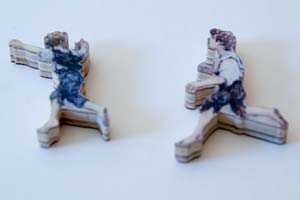 6c Multiple levels-same wood
6c Multiple levels-same wood
For The Pickwickians Leave the Golden Cross for Rochester, Graham Curtis has glued the entire raised area onto plywood dispensing with the need for a second copy of the scene for the lower layer.
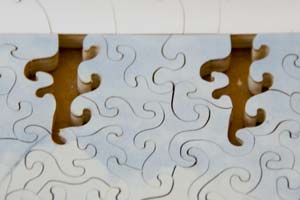 7a Double cutting-sections
7a Double cutting-sections
Melinda has double cut at least one piece in Mr. Pickwick and his Friends Arrive at the Blue Lion. There may be more.
7b Double cutting-deception
Melinda says she employed double cutting-deception but I have yet to find it as she has cut so much of the entire puzzle.
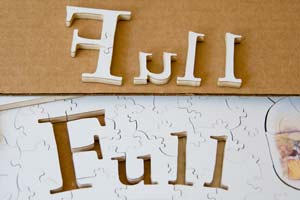 7c Double cutting-reversing pieces
7c Double cutting-reversing pieces
Melinda has double cut in reverse the letters spelling "Full". They simply won't fit with the white side up, only with their brown backs showing!
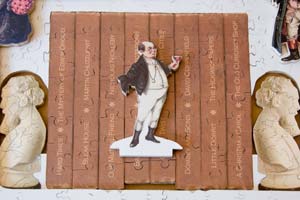
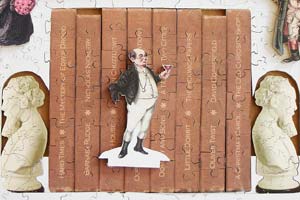 7d Double cutting-challenge
7d Double cutting-challenge
Melinda has used her imagination and double cutting for the works of Dickens in the center section so that the pieces assemble in at least two ways, the correct solution being with both slots together along the bottom to hold the pop-up figure of Mr. Pickwick.

 8 Loose cut-challenge
8 Loose cut-challenge
I believe this occurs in Stave Puzzles' section, Mr. Pickwick, his Friends and Mr. Jingle Start for Rochester but I am not certain.
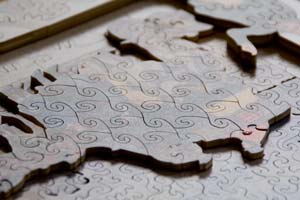 9 All pieces same shape
9 All pieces same shape
This can be observed in the top layer of Melinda's section, Mr. Pickwick and His Friends Arrive at the Blue Lion.
10 Collage puzzle
The entire puzzle is a collage puzzle with the artwork assembled in its final form by Photoshop instead of what I had to do 15 years ago before Photoshop in The Magic of Mozart. Yes, modern technology does render obsolete old ways of doing things!
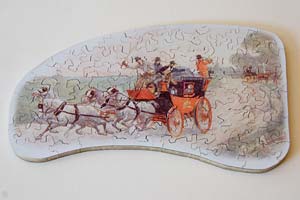
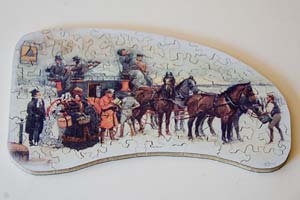 11 Two-sided puzzle
11 Two-sided puzzle
Each of the four coaching scenes cut by Joe Seymour on either side of the center section have different Ludovici Dickens coaching scenes on their backs, and David Copperfield's First Sight of London cut by Anne Williams has the same coaching scene on front and back.
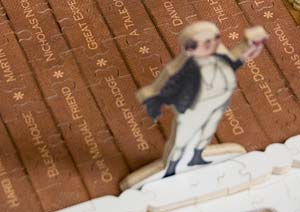 12a 3-D pop up
12a 3-D pop up
The pop-up figure of Mr. Pickwick cut by Melinda.
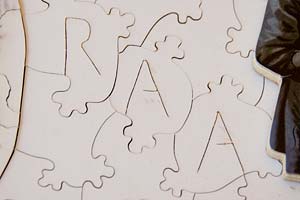
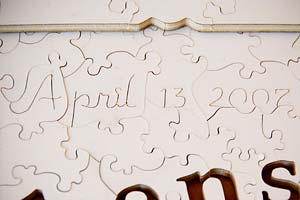 In cutting RAA and April 13, 2007 in the two sections on either side of the center section, Melinda has used a new technique called "scripting".
In cutting RAA and April 13, 2007 in the two sections on either side of the center section, Melinda has used a new technique called "scripting".
 Also, a cutter in England has claimed a new technique by deliberately splitting the holes (keys) into which knobs lock. This is frequently done in most random cut intricate puzzles and can be observed in Pagey Elliott's section.
Also, a cutter in England has claimed a new technique by deliberately splitting the holes (keys) into which knobs lock. This is frequently done in most random cut intricate puzzles and can be observed in Pagey Elliott's section.
In effect, my initial list of 38 special cutting techniques has reached 40, with Full of the Dickens containing examples of 37 of them. Only ones missing are: 4e: Dropouts-challenge, 12b: 3-D constructional, 12c: 3-D puzzle into game. A most impressive achievement!